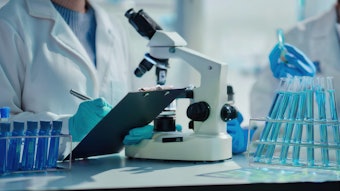“Water is life’s matter and matrix, mother and medium. There is no life without water.”—Albert Szent-Gyorgyi
To see one of nature’s greatest miracles, turn on the tap. The properties of water pouring forth defy total understanding. Cosmetics are mostly water. The cells you try to beautify, protect and repair are mostly water. Simply saying that water is “H20” obscures its true nature, and attaching a simple label to it is likely to discourage the further pursuit of its mysteries. It is similar to wearing a t-shirt of Einstein sticking out his tongue and thinking that it implies a profound grasp of the theory of relativity by its wearer.
The structure of liquid water traditionally has been viewed as a looser form of ice, in an overall tetrahedral arrangement. Conventional wisdom is that water is unique among all molecules, not because it is polar and forms hydrogen bonds, but because each oxygen bonds to four hydrogen atoms, giving it unusual strength. Two bonds are covalent and two are polar.
However, researchers, using X-ray absorption and X-ray Raman scattering, imply that liquid water molecules take part in only two hydrogen bonds, not four, and that these are in a planar arrangement.1 This result suggests that water exists in hydrogen-bonded chains or large rings. Researchers found an asymmetry in the charge distribution of the water molecule—one hydrogen has significantly more electron density than another. The hydrogen with greater electron density would not be able to participate in a hydrogen bond, thus countering the traditional view that all hydrogen atoms are involved in hydrogen bonds in a tetrahedral arrangement. Instead, they believe that this asymmetry implies a linear structure, with a hydrogen atom on one side of the central oxygen participating in a hydrogen bond while an electron pair on the opposite side participates in a hydrogen bond with the next molecule on the chain.
Proteins in cells exist in an aqueous environment. Computer modeling allows a closer look at how water affects the structure, and consequently the function, of biological molecules.2 In 1986, the dark ages of data crunching, two weeks on a supercomputer was used to model bovine pancreatic trypsin inhibitor in water. The particular protein chosen is relatively small and had previously modeled in vacuo. The differences in the results with and without water showed the importance of water for protein structure and activity.
Proteins are long chains with both hydrophilic and hydrophobic sections. Their three-dimensional structure is determined by how the chains fold, with the hydrophilic parts on the surface, and the hydrophobic parts in the interior. Three types of water must be built into a computer model of protein interaction. Ordered waters surround and strongly interact with the molecule, bulk waters are further away, and some water is buried within the protein.
Of particular interest is the interaction of water with the deep grooves on the surfaces of enzymes. Water is easily displaced from the grooves by ligands, which may explain why the grooves are frequently the active sites. The arrangement of water molecules in the groove often corresponds to the geometry of the ligand, which is a valuable clue for rational drug design.
Water has been a mainstay of cosmetics, and while you have just seen the importance of water for the structure of protein, now The New York Times warns,3 “Dangerous When Wet … The worst thing you can do for you skin may well be washing it with water.” It seems water is a lethal broth of heavy metals: iron, copper, magnesium, zinc and lead. They interact with free radicals and attack collagen. Calcium is not a heavy metal, but creates hard water that leads to dull, dry skin and hair.
MD Skincare4 has attacked the metals with Hydra-Pure Moisture Cream, basing its value on the presence of chelators. Clarins5 also is combating the wash-and-rinse ritual with its Water Purify: “The feeling of cleansing with water without water.” There now is a notable trend toward anhydrous products and cleaning without water for both skin and hair.
So far the garden variety of water has been discussed, but chemistry has designer water also, and it finds its way into cosmetics. Deuterium is hydrogen where each nucleus has a neutron as well as a proton. This makes it twice as heavy as normal hydrogen. Heavy water is water in which both the hydrogens are replaced by deuterium.
What can it do in personal care? According to Sircuit Skin,6 “Heavy water is 10% heavier than H2O and is known as D2O (deuterium oxide). Not only will it hydrate and plump your cells, but it fights certain acne bacteria as well. It evaporates more slowly than regular water and provides necessary hydration and natural moisture to the skin. Heavy water is believed to be the original water and is found in all water on the planet.”
Other claims,7 “Heavy water has a higher resistance to vaporization, which helps it stay on the skin for longer periods of time, as it has more viscosity. This ‘thickness’ gives it a higher ‘plumping’” effect than regular water and the skin does not dry out as quickly or as deeply. It requires 10 times the energy for ionization than regular water, which makes it more protective against ultraviolet radiation. It inactivates certain acne bacteria, making it an ideal moisturizing agent for blemish-prone skin.” The properties of D2O are indeed measurably different from H2O: for example, the viscosity is about 11% higher at 25° C.
With all the high-tech ingredients in development, it is easy to overlook the significance of water. For such a small and apparently commonplace molecule, water has yet to yield all its secrets. The personal care industry has found both benefits and problems in its use. Its value has become schizophrenic, with some products designed to hydrate, and others attempting to counteract its negative effects. Water, water everywhere—what are we to do about it?
References
- Wernet et al., The Structure of the First Coordination Shell in Liquid Water, Science, 995–999 (May 14, 2004)
- M Gerstein, and M Levitt, Simulating Water and the Molecules of Life, Sci Am 279: 100–5 (Nov 1998)
- C Druckman, Dangerous When Wet, The New York Times Magazine (Feb 5, 2006)
- www.mdskincare.com
- http://sg.clarins.com
- www.sircuitskin.com
- www.mineralsecrets.com/mineral-secrets-bases.htm










